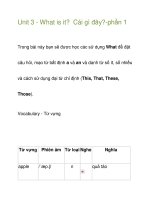Problem solving what is it
Bạn đang xem bản rút gọn của tài liệu. Xem và tải ngay bản đầy đủ của tài liệu tại đây (1.01 MB, 45 trang )
Problem Solving: What is it
and Why is it Important?
•
Janine McIntosh:
•
Michael O’Connor:
Problem Solving
What, exactly, is Problem Solving?
Take a few moments to write down your current
working definition of Problem Solving.
Problem Solving
Why is it important?
Now write down why it is important to include problem
solving as a core element of the mathematics
curriculum.
If you disagree with it being given such a central role,
write down your reasons for this instead.
Problem Solving
When and How often
In your classroom currently:
When do you work on problems and problem solving?
How often do you spend at any one time?
Problem Solving
How good are you?
On a scale from 1 to 10, give yourself a score for how
confident you feel in solving problems.
Problem Solving
The “Official” Definition
Students develop the ability to make choices, interpret,
formulate, model and investigate problem situations,
and communicate solutions effectively. Students
formulate and solve problems when they use
mathematics to represent unfamiliar or meaningful
situations, when they design investigations and plan
their approaches, when they apply their existing
strategies to seek solutions, and when they verify that
their answers are reasonable.
(ACARA, )
Problem Solving
Year Level Descriptions
In addition to this overall statement, ACARA also has
descriptions for what Problem Solving looks like at each
year level.
These are available in collated form both on Calculate
and in the AMSI Teacher Journal. They are also
reproduced in the following slides.
Problem Solving
Years F to 2
Year
Description
F
Problem Solving includes using materials to model authentic
problems, sorting objects, using familiar counting sequences
to solve unfamiliar problems, and discussing the
reasonableness of the answer
Model, solve,
discuss
reasonableness
1
Problem Solving includes using materials to model authentic
problems, giving and receiving directions to unfamiliar
places, and using familiar counting sequences to solve
unfamiliar problems and discussing the reasonableness of
the answer
Problem Solving includes formulating problems from
authentic situations, making models and
using number sentences that represent problem situations,
and matching transformations with their original shape
Model,
communicate
directions, solve,
discuss
reasonableness
Formulate, model,
comparison
matching
2
Keyword
Problem Solving
Years 3-4
Year
Description
Keyword
3
Problem Solving includes formulating and modelling authentic Formulate, model,
situations involving planning methods of data collection and
representation, making models of three-dimensional objects
and using number properties to continue number patterns
4
Problem Solving includes formulating, modelling and
Formulate, model,
recording authentic situations involving operations, comparing record, compare
large numbers with each other, comparing time durations, and
using properties of numbers to continue patterns
Problem Solving
Years 5-6
Year
Description
Keyword
5
Problem Solving includes formulating and solving authentic
problems using whole numbers and measurements and
creating financial plans
Formulate,
6
Problem Solving includes formulating and solving authentic
problems using fractions, decimals, percentages and
measurements, interpreting secondary data displays,
and finding the size of unknown angles
Formulate, solve,
interpret,
Problem Solving
Years 7-8
Year
Description
7
Problem Solving includes formulating and solving authentic
problems using numbers and measurements, working with
transformations and identifying symmetry, calculating
angles and interpreting sets of data collected through
chance experiments
Problem Solving includes formulating,
and modelling practical situations involving ratios, profit
and loss, areas and perimeters of common shapes, and
using two-way tables and Venn diagrams to calculate
probabilities
8
Keyword
Formulate, solve,
identifying
“symmetries”,
interpret
Formulate, model,
convert/translate
information
Problem Solving
Years 9-10
Year
9
10
10A
Description
Problem Solving includes formulating,
and modelling practical situations involving surface areas
and volumes of right prisms, applying ratio and scale factors
to similar figures, solving problems involving right-angle
trigonometry, and collecting data from secondary sources to
investigate an issue
Problem Solving includes calculating the surface area
and volume of a diverse range of prisms to solve practical
problems, finding unknown lengths and angles using
applications of trigonometry, using algebraic and graphical
techniques to find solutions to simultaneous equations and
inequalities, and investigating independence of events
No additional comments
Keyword
Formulate, model,
apply, solve,
investigate,
Apply, investigate,
Problem Solving
“Problem solving at its most general was defined
as trying to achieve some outcome, when there
was no known method (for the individual trying
to achieve that outcome) to achieve it ...
complexity or difficulty alone did not make a
task a problem”
Schoenfeld, 2013
Problem Solving
Polya: How to Solve it.
First published in 1945, it says there are 4 stages in
solving any problem
1) Understand the problem
2) Devise a plan
3) Carry out the plan
4) Look back
Problem Solving
A Satchel of Strategies
Or a Toolbox of Techniques.
These can be built up over
the years.
Often, a list of strategies,
along with the 4 stages, are
written on the classroom
Maths Wall.
Some example strategies
• Guess and check
• Look for a pattern
• Draw a table
• Reduce to a simpler case
• Act it out
• Work backwards
• Draw a sketch
• Divide into subtasks
• Substitute simple values
Problem Solving
Wolfram’s “Doing Maths”
Reproduced with permission. Copies of the poster are available at:
/>
Problem Solving
Polya again
Connecting the
other Proficiencies
1) Understand the problem
Understanding
2) Devise a plan
Reasoning
3) Carry out the plan
Reasoning & Fluency
4) Look back
Feedback, reflection
and metacognition
Problem Solving
Why is it Important?
1) Mathematics is more than just calculation.
2) Real life, modern society and civilisation is full of
problems large and small.
3) Promotes links between concepts and topics leading
to greater understanding and new learning
Problem Solving
What makes a good Problem?
These are
regarded as
the essential
minimum for
selection of
all problems
Why is Problem Solving Important to Student Learning, NCTM Research Brief, April 2010
Problem Solving
What makes a good Problem?
These criteria add
value at different
times to the
collection of
problems being
used.
Why is Problem Solving Important to Student Learning, NCTM Research Brief, April 2010
Problem Solving
Developing an Integrated Approach
Involves developing a mindset and a process to help
students
a) build skill and capacity
b) encourage perseverance
c) reflect on thinking
d) recognise multiple solutions may be possible
Problem Solving
Developing an Integrated Approach
More than just a learning a strategy a week.
While having a set of strategies is important, so is
choosing which strategy to use in a given situation and
justifying this choice.
Problem Solving
Sense Making
MGA Spiral of developing
understanding
Mason, J., et al, (2005), Developing Thinking in Algebra, SAGE Publications
Problem Solving
The Zone of Proximal Development (ZPD)
Developed by Vygotsky in the 1930’s in Soviet Union.
Not until 1970’s that ideas reached the West.
Used to assist students in the acquisition of knowledge
and skills
Useful also for formalising problem solving processes
Problem Solving
The Zone of Proximal Development (ZPD)









